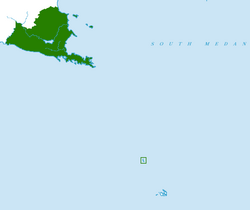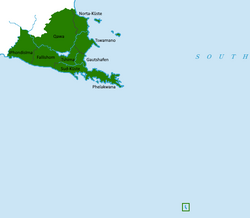Borvastaat
This article is incomplete because it is pending further input from participants, or it is a work-in-progress by one author. Please comment on this article's talk page to share your input, comments and questions. Note: To contribute to this article, you may need to seek help from the author(s) of this page. |
Republic of Borvastaat 4 official languages
| |||||||||
|---|---|---|---|---|---|---|---|---|---|
| Anthem: National Anthem of Borvastaat
| |||||||||
 Location of Borvastaat in Hylasia | |||||||||
 Subdivisional map of Borvastaat | |||||||||
| Capital | Gautshafen | ||||||||
| Largest city | Tshimberg | ||||||||
| Official languages | Borvazunge Ruthish Seloleme Ulwimi | ||||||||
| Recognised regional languages | Sebua !qáxa Fallish | ||||||||
| Ethnic groups (2022) | 26.7% Batho 21.2% Bachaba 17.6% Ixolo 15.8% Ruthish 6.7% Fallish 5.8% Mixed/Colored 3.3% tǃʼàu 2.3% Yinese/Abarian 0.8% Other | ||||||||
| Religion (2022) | 74.3% Gregorianism 13.4% No religion 9.1% Folk religion 2.2% Himayan 1% Other | ||||||||
| Demonym(s) | Borvazi Borvastaater | ||||||||
| Government | Unitary Combinationalist Parliamentary republic with an Executive presidency | ||||||||
| Kagiso Motsepe | |||||||||
• Speaker | Mpho Molefe | ||||||||
| Naledi Sepogodi | |||||||||
| Legislature | National Assembly | ||||||||
| History | |||||||||
| c. 400-2,000BCE | |||||||||
| c. 900-1300CE | |||||||||
| c. 1630CE | |||||||||
| 1 November 1864 | |||||||||
| 18 October 1944 | |||||||||
| 15 April 1984 | |||||||||
| Area | |||||||||
• Total | 853,285.7 km2 (329,455.5 sq mi) | ||||||||
• Water (%) | 1.01 | ||||||||
| Population | |||||||||
• 2022 estimate | |||||||||
• Density | 60.43/km2 (156.5/sq mi) | ||||||||
| GDP (PPP) | 2022 estimate | ||||||||
• Total | |||||||||
• Per capita | |||||||||
| GDP (nominal) | 2022 estimate | ||||||||
• Total | |||||||||
• Per capita | |||||||||
| Gini (2022) | high | ||||||||
| HDI (2022) | high | ||||||||
| Currency | Gauta (Ǥ, BSG) | ||||||||
| Time zone | UTC-1 (Borva Standard Time, BST) | ||||||||
| Date format | dd-mm-yyyy | ||||||||
| Driving side | right | ||||||||
| Calling code | +144 | ||||||||
| Internet TLD | .bs | ||||||||
Borvastaat, officially the Republic of Borvastaat[a], is a sovereign state and the southernmost country in Hylasia. Its nine provinces are bounded to the south by the Galanaic Ocean and to the east by the South Medan Ocean; to the north the nations of X, X, and X. It is the southernmost country on the mainland of the Old World and the second-most populous country located entirely south of the equator, after Nadauro. With a population of over 51 million people, it is currently the 9th most populous nation on Teleon and covers an area of 853,285.7 square kilometres (329,455.5 square miles). Its capital city is Gautshafen while the largest city is Tshimberg.
About 70% of the population are Black Borvastaaters. The remaining population consists of Hylasia's largest communities of Calesian (White Borvastaaters), Abarian (Yinese Borvastaaters), and multiracial (Coloured/Mixed Borvastaaters) ancestry. Borvastaat is a multi-ethnic society encompassing a wide variety of cultures, languages, and religions. Its pluralistic makeup is reflected in the Constitution's recognition of 4 official languages with 3 official recognized minority languages. According to the 2022 census, the two most spoken first languages are Seloleme (24%), spoken as a first language by nearly a quarter of the country's population, and Borvazunge (16.0%), the latter being of Calesian origin. Other Calesian languages spoken in the country are Ruthish (13.6%) and Fallish (7.6%), reflecting the influence of colonialism on the country.
Regular elections have been held in the country for four decades now, though the settler population carried out its own elections for another four decades prior to that. The vast majority of Black Borvastaaters were not enfranchised until 1984. During the 20th century, the black majority sought to claim more rights from the dominant white minority, which played a large role in the country's recent history and politics. The now defunct People's Party imposed apartheid in 1945, institutionalizing previous racial segregation only a year after the country was given independence from the Transmedan Powers in the aftermath of the Great War. After a mixture of guerrilla warfare and non-violent struggles by the Borvastaat National Party and other anti-apartheid activists both inside and outside the country, the repeal of the apartheid legal framework began in 1981 and ended in 1984. Since 1984, all ethnic and linguistic groups have held political representation in the country's liberal democracy, which comprises a parliamentary republic and nine provinces. Borvastaat is often referred to as the "rainbow nation" to describe the country's multicultural diversity, especially in the wake of apartheid.
Borvastaat is a middle power in international affairs; it maintains significant regional influence and is a member of the Non-Aligned Movement, the United Congress, the Hylasian Union, and various regional organizations. It is a developing country, ranking 11th on the Human Development Index, among the highest on the continent. Borvastaat is also one of the few Hylasian nations to have legalized same-sex marriage. It has also been classified as a newly industrialized country and has the largest and most industrialized, technologically advanced economy in Hylasia. Since the end of apartheid, government accountability and quality of life have substantially improved. However, crime, poverty, and inequality remain widespread, with about 40% of the total population being unemployed as of 2021, while some 60% of the population lived below the poverty line and a quarter lived below $2.15 a day.
History
Pre-History
Borvastaat contains some of the oldest archaeological and human-fossil sites in the world. Archaeologists have recovered extensive fossil remains from a series of caves in Qawa Province. These finds suggest that various hominid species existed in Borvastaat from about three million years ago, starting with Australopithecus hominids. Modern humans have inhabited Southern Hylasia for at least 170,000 years. Various researchers have located pebble tools within the Umlambo River valley. While the region was devoid of any sedentary civilization for some time, the indigenous proto-tǃʼàu peoples, primarily divided amongst hunter-gatherers and pastoralists, were among the earliest long-term inhabitants. This region remains as one of the longest continually inhabited regions in the world.
uMzantsi Migrations
Around 1,000-2,000BCE, other nomadic groups from central parts of the Hylasia began migrating south, displacing, eliminating, and/or assimilating various other cultures. These migrations are referred to in Ulwimi as the “uMzantsi” or “southerly” migrations, where many of the more populous ethnic groups in the country today come from, like the Batho, Bachaba, and the Ixolo. Some uMzantsi languages, like Ulwimi and SeBua also borrowed some click consonants from the indigenous !qáxa languages (of the tǃʼàu peoples).
These migrations continued, primarily into the coastal regions where they displaced the tǃʼàu people into the central lands (modern day Qawa province), until around the 4th century BCE. They were fueled by the advent of agriculture and the iron age, which allowed for people from the central Hylasian climates to better adapt to the different southern climates.
This ethnic makeup remained fairly stable for a while, with the Kingdom of Motlalepula, the first true regional polity, forming around 900 CE and ending around 1300 CE. It saw advances in stone masonry, gold and ivory trade, and organized agriculture. Additionally, it was one of the largest such kingdoms of this period in the sub-equatorial parts of Hylasia, encompassing all of modern-day Borvastaat, in addition to vast swathes along the Inkazana river into parts of modern-day X, X, and X.
The collapse of the Motlalepula, brought on by climate changes from the Catabolic Crisis, led to a period of instability in the region, as well as divides amongst the once stable ethnic lines that had been established thousands of years earlier. This period, lasting the duration of the Catabolic Crisis, saw the near-extermination of the tǃʼàu people, and famines that affected the more dominant Batho (central-south), Bachaba (north), and Ixolo (southwest) groups, often causing them to go after the food sources of the pastoralist or hunter-gatherer tǃʼàu people.
Calesian Exploration
Around the time of the collapse of the Motlalepula, in the early- to mid-1400s, some of the first contact was made with non-Hylasian peoples, including the arrival by land of Himayan missionaries and the arrival by sea of Yinese and Calesian traders. While few permanent settlements were made by these groups, the introduction of smallpox yet again struck at the population of the region. By the early 1500s, the indigenous population had been nearly halved from what it was in the mid-1300s.
This, along with small skirmishes and conflicts near areas being settled by Calesian traders, saw much of the prominent coastal regions become devoid of permanent human habitation, with many native groups being relegated to inland agriculture and nomadism. With the advent of these new sea lanes connecting western Abaria to Calesia, as well as areas ripe for whaling off the southern coast, the region quickly became a large trading hub, with some settlers from Falland and the Ruthish Confederation finally establishing permanent settlements, often based on agriculture and maritime trading in the early 1600s.
Many of the smaller coastal settlements established during this period went on to become some of the larger modern cities, and while no country laid any official claim during this period, some tensions did exist amongst the Fallish and Ruthish settlers, sometimes escalating into skirmishes. This finally escalated into a full conflict around the early 1700s when Fallish settlers attempted to settle further inland, signing a series of exploitative treaties with the native Batho and Ixolo peoples in an attempt to surround Ruthish settlements along the central and southern coastlines. During this time, the “Settler War” took place, from 1752-1757, with many Fallish settlers having to resettle along the south and central inland regions, all the while the Ruthish settlers seized the Phelakwana peninsula and much of the northern and central coast, essentially winning the war.
Ruthish Colonization
This post-war situation remained relatively distant from the mainlands of Falland and the Ruthish Confederation/Kingdom, and the established borders remained stagnant until the scramble for parts of Hylasia in the mid- to late-1800s, in which the Ruthens were awarded all of the modern Borvastaat, while Falland retained some rites of passage. The “Kolonie von Süd-Hylasia” then existed from 1864 onwards, with periods of increasing immigration, and conflict with the natives, including the “Batho War” of 1866-1870, and the further displacement of Fallish settlers (Fallishimi) to the southwest and western regions in the 1870s and 1880s (known as the Fallishimitrek).
Many Ruthish settlers hoped to create a Ruthish-speaking state, and these forced displacements and wars became especially crucial after the discovery of diamonds in 1871 (with a gold rush having occurred some decades earlier, spiking immigration then as well). This diamond rush saw the beginning of the modern state of Borvastaat. Many independent Ruthish prospectors and native forced laborers were resigned to intermingle in this era, during which multiple pidgins popped up, which also gave way to the modern name of Borvastaat, meaning “Borwa” (South or southern in Seloleme) and “Staat” (state in Ruthish).
The repression of workers of all creeds during the diamond rush and ensuing industrialization and immigration saw a rise in conflicts, strikes, and military deployments. As industrialization continued, so too did the repression, culminating in a sizable communist influence by the turn of the century. Many indigenous groups would even band with the Fallishimi and some Ruthish workers on occasion to combat Ruthish military personnel, leading to the “1st Baagisan-konflikt” (1st Settler Conflict), in which an all-out war was mounted against the Ruthish colonial army. The main part of the war lasted only a brief 3 years, from 1919-1922, but a low-level conflict persisted through to the start of the Great War.
During the Great War, the Kolonie von Süd-Hylasia fell in its entirety to the Transmedan Powers in August of 1937, resulting in its occupation until 1944 by the Transmedan powers.
Independence and Apartheid
After the Great War, an independent republic was established, one intended to represent all of its inhabitants; however, it did not last long and quickly fell back into a civil conflict with the “National Coup” of October 29th, 1945, when a group of armed settlers and associated military units rose up, overthrowing the government and establishing an apartheid state. The immediate aftermath of the coup was the disarmament of unions, indigenous peoples, and the Fallishimi, which then led to the “2nd Baagisan-konflikt.”
This conflict consisted primarily of labor strikes, protests, international activism, and on occasion the use of terrorism and insurgencies among more radical groups. Moreover, the apartheid system lasted for 36 years, ending only in 1981 with the Gautshafen and Tshimberg Agreements. The former established a 3-year transition period to get rid of the apartheid, while the latter established a ceasefire and freed many political prisoners. The collapse of the apartheid system was due to the internal conflicts, as well as international isolation through the 70s and early 80s, forcing the government to go back on its ways.
The apartheid state of Süd-Hylasia was also heavily intertwined with anti-colonial and anti-communist military operations throughout Hylasia, often reflecting domestic issues. These conflicts and international pressure due to apartheid policies eventually led to the Süd-Hylasian nuclear program, where the government produced an estimated dozen-or-so nuclear weapons and tested one in 1978 in the Qawa province. However, this had a reverse effect, causing even more backlash, and leading to the downfall of apartheid.
Post-Apartheid
From 1984 onwards, the country officially changed its name from Süd-Hylasia to Borvastaat and established itself as a “Rainbow Republic,” with nearly 1 in 4 people being descended directly from the earlier settler populations. This situation has proven to be largely a success story, although there was a minor exodus of the Ruthish settler population around the end of apartheid.
Discrimination is still widespread in Borvastaat, though significantly better than during the period of apartheid. This is largely due to the concentration of wealth amongst the settler population, ethnic tensions within the nation, and TBD
Geography
Climate
Biodiversity
Government and Politics
Foreign Relations
Military
Law Enforcement & Crime
Administrative Divisions
Economy
Demographics
Culture
Notes
- a.^ Borvazunge: Rephublik Borvastaat; Ruthish: Republik Borvastaat; Seloleme: Rephaboliki X; Ulwimi: iRiphabhlikhi X


